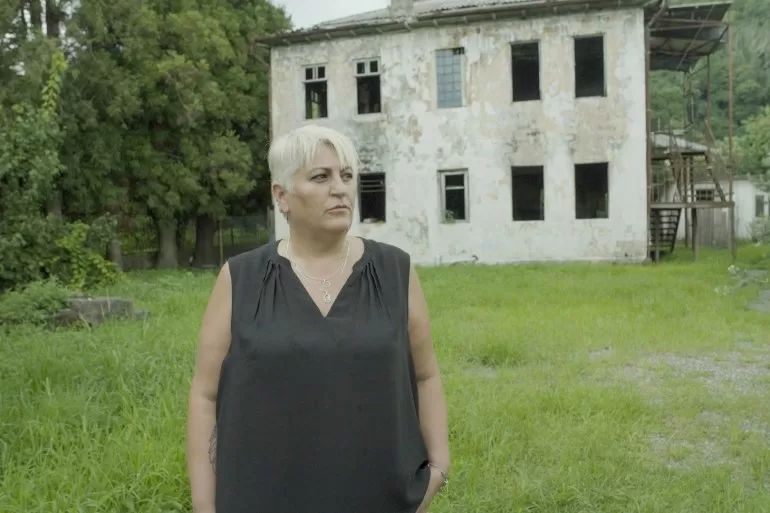“When my father was dying, in his final days, he kept talking about my grandfather, asking why he was shot, where he was taken,” Natalia, 48, recounts. “‘I don’t know where Hasan is’, my father would say. ‘He was thrown somewhere like a dog.’”
Scorched and deserted after a recent fire, the house is a forlorn structure standing in a large plot behind the family home in a village not far from the southwestern Black Sea port city of Batumi.
For Natalia’s father, Iakob Kuznetsov, the house was a daily reminder of Hasan’s disappearance more than 80 years ago, and a symbol of intergenerational grief passed on to Natalia from his deathbed.
Hasan was among the thousands of people rounded up by the Soviet secret police and accused of being “enemies of the state” in a campaign known as the Great Terror. Under the leadership of Joseph Stalin, mass executions of innocent citizens were committed across the Soviet Union in successive waves of repression, and vast numbers of people were deported or sent to prison camps. Many families of those executed never found out what happened to their loved ones.
In Georgia, almost 15,000 people are believed to have been killed. In the absence of a committed national effort to investigate Soviet crimes and revisit official history, sociologists point to widespread amnesia, ambivalence and even denial among Georgians that such executions took place.
Since Georgia’s independence from the Soviet Union in 1991, Georgian-born Stalin has achieved mythic status in the imagination of many of his compatriots. He remains a powerful and divisive figure, remembered both as a brutal dictator, and as a national hero who led the USSR to victory over Nazi Germany.
With Georgians still struggling to come to terms with their past, efforts to investigate Stalin’s Terror, and locate victims, are gathering momentum.
Forensic experts, historians and the families of those who went missing are taking it upon themselves to heal a national trauma. Through detective work and public awareness raising, they are attempting to find and identify the victims of decades-old atrocities.
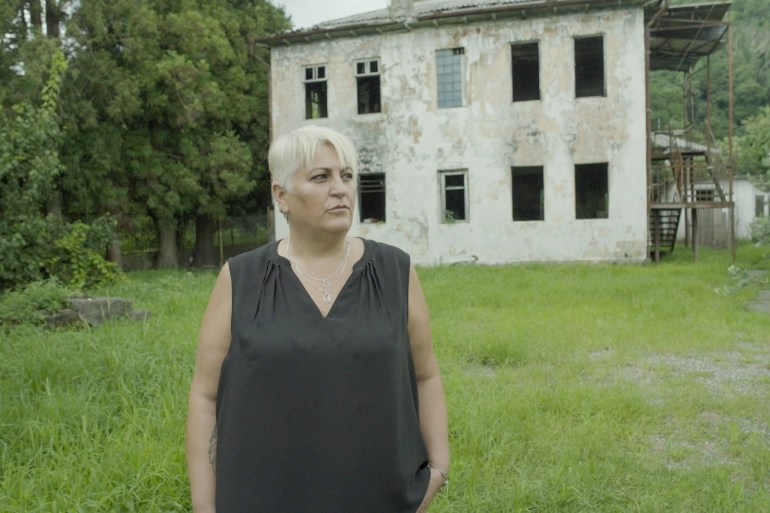
Boxes of bones
A musty smell emanates from a basement room at Tbilisi State Medical University. It is the smell of earth and of something else.
Inside, Meri Gonashvili from the Georgian Association of Forensic Anthropology (GAFA) is dressed in black theatre scrubs and surgical gloves.
“This is Georgia’s first forensic anthropology laboratory,” says the 35-year-old with pride.
Dozens of boxes of human bones are stacked in rows against a wall, each labelled with a unique code. They are the source of the distinctive odour.
Meri lifts a large cardboard box onto a foldaway table containing the bones of a single human skeleton.
She removes fragments of skull from a brown paper bag, and begins to carefully reassemble the pieces with adhesive tape.
The victim died from a single shot to the head, a perfect circular hole at the back of the skull marking the bullet’s entry, and a jagged cavity above the right eyebrow indicating its exit.
“We see evidence of trauma,” the forensic anthropologist states matter-of-factly. “Especially occupying the occipital region and posterior aspect of the parietals.”
For Meri, this medical lexicon helps serve as an emotional firewall against the tragedy of this person’s violent death at the hands of Soviet Georgia’s secret police.
“It is impossible for such kind of tragic events that happened to your society not to affect you mentally,” admits Meri. “But you should bury this kind of emotional things with your mind and just keep working.”
From another box Meri pulls out a series of artefacts found at gravesites.
“This shoe is very common,” she says, turning a flattened galosh over in her hands, “and underneath is printed the stamp USSR in Cyrillic, and a number, 37. This could be the year of manufacture. Not the shoe size.”
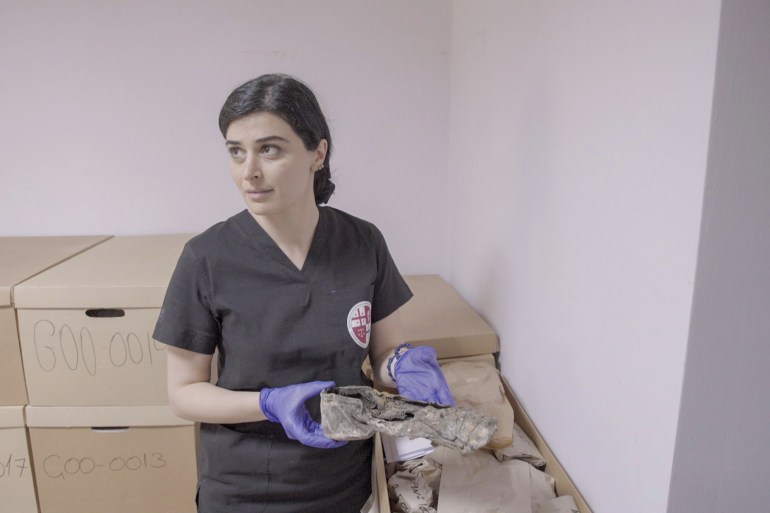
‘We do it for the families’
In what became known as the Great Terror or Purge, Stalin authorised the arrests of anyone suspected of plotting against him, following the assassination of senior Bolshevik leader Sergei Kirov in 1936. Coordinated by the secret police, the NKVD (People’s Commissariat for Internal Affairs), what began with the targeting of high-ranking party officials quickly expanded to rounding up ordinary citizens.
In the late 1930s, anyone suspected of counter-revolutionary thoughts or activities was targeted, from educated and respected village elders to clergy, writers, workers and peasants. Between 1937 and 1938, the NKVD executed an estimated 700,000 to 1.2 million Soviet citizens.
GAFA’s laboratory contains the first victims to have been exhumed in Georgia – the skeletal remains of approximately 150 people – from a series of mass graves at a military base close to Batumi in the autonomous Adjara region.
Meri is facing a task that could last a lifetime: Locating and identifying the thousands of Georgians tried and shot during this period.
“Everybody just talks about DNA, DNA, but before DNA, we need laboratory work and forensic anthropological analysis,” she cautions. “If you incorrectly assemble one individual then you can send the wrong sample to the DNA lab.”
Then, her composure breaks, and her voice trembles. “We do it for the families,” she says. “We owe it to these people, to the victims, to do everything in our capacity to return them back to their families.”
Muslim victims
In 2019, the Georgian Orthodox Church announced it had completed excavations of the first of Stalin’s victims in the country at a site locals had suspected was an execution ground.
It said 150 bodies had been exhumed since 2017 from four mass graves at a former Soviet military base in Khelvachauri and that the remains would soon be reburied. Not a single individual had been identified.
Academics and researchers working on Soviet repression regretted that forensic experts and historians had not been involved.
Reburial “would leave many questions unanswered,” civil society organisation the Institute for Development of Freedom of Information (IDFI) said at the time.
IDFI had compiled a list of 1,050 individuals executed in Adjara from surviving Soviet documents and hoped it might be possible to trace descendants and reunite families with the remains.
Meanwhile, Muslim leaders objected to the Orthodox Church’s unilateral involvement. The Supreme Religious Administration of Muslims of All Georgia was wary of a mass Christian reburial when many of the Adjara victims were known to have been Muslim. In the 1930s, Adjara had a large Muslim population and the Soviet authorities were known to target religious and ethnic minorities.
Facing pressure, the Church halted its reburial plans, and the Adjaran government set up a special commission under its health ministry to study the issue.
“I just called to offer my help,” explains Meri, who had seen media reports about the discovery.
“I went there and I saw the situation. These skeletal human remains had been exhumed and stored in the basement of a church,” she recalls. “It appeared no specialist had been involved there, no proper methodology was being used.”
Together with GAFA, experts from the American Academy of Forensic Sciences were invited to participate in the excavation of a fifth mass grave at the same military base in August 2021.
Twenty-eight bodies were found with their hands tied behind their backs and gunshot wounds to their heads.
“When you open and excavate the gravesite, the bodies, how they are organised – they tell the stories by themselves,” says Meri, a hint of anger in her calm voice. “They were thrown [there] like animals, not human beings.”
Later, in February 2022, IDFI, collaborating with the Georgian Orthodox Church, announced the results of a parallel investigation – the recovery of 29 bodies from a sixth mass grave at the same site. This time, the excavation was carried out by Polish experts and the unearthed bodies also showed the same signs of execution.
Two separate investigations are now under way, led by separate organisations, dependent on the support and resources of different international partners.
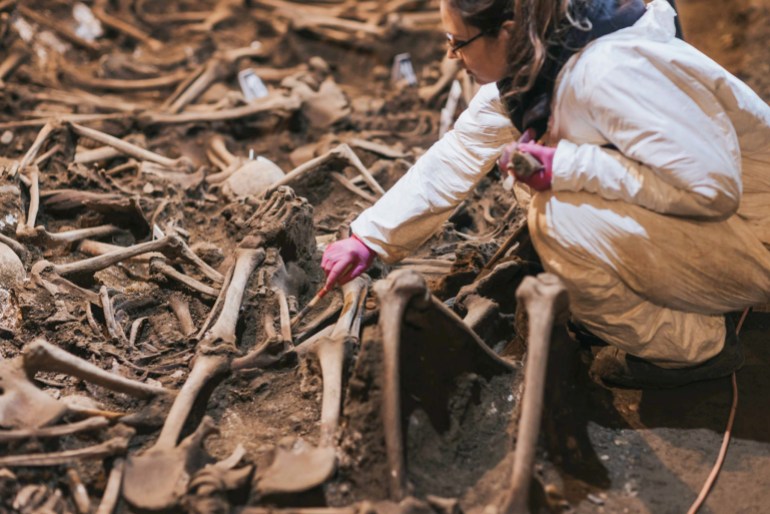
Carrying a burden for decades
Locals whose relatives disappeared during the 1930s were invited to visit GAFA’s work. Staring into the pit at Grave 5, Zura Zakharaidze wept. He hoped that the mass grave would reveal its secrets, and relieve his family of a burden it had been carrying for decades.
“My great-grandfather Kedem Agha was a philanthropist. He built the first Georgian school in my village. Unfortunately, such a man as he was arrested and shot in 1937.”
Back at his home in the picturesque Adjaristsqali valley, Zura, 57, brings out sepia and black-and-white photographs of three men dressed in 1930s attire.
One photograph shows Kedem, Zura’s great-grandfather, a bearded man in his 40s, wearing a sheepskin hat.
Another shows Zura’s grandfather, Ismail, together with his brother Suleiman, both in their 20s, sporting clipped moustaches. Ismail wears a suit and bow tie. Suleiman is dressed in a military coat and a peaked cap.
In a story that has been passed down in his family, witnesses recalled his grandfather attending a local village council after Kedem and Suleiman were arrested.
“‘If my father and brother are enemies, then I am also an enemy,’ my grandfather said,” Zura explains. “And from that day, my grandfather, Ismail, disappeared.”
All three of Zura’s relatives are on IDFI’s aggregated list of executions, but Zura’s DNA has not been linked to any of the remains recovered so far.
“Our great-grandmother, my father’s grandmother, Aishe Tavdgeridze, suffered so much,” Zura says. “Tears in her eyes were not drying, our family endured such a great tragedy and this pain follows all of us to this day.”
Zura’s determination to find his missing ancestors extends to helping others in the same plight. His Adjara Memorial foundation, established by his father in 1997, coordinates with the Adjaran commission to locate victims’ families or connect families to the commission.
“DNA analysis of all found remains should be done and the search for other repressed people should continue,” he says resolutely.
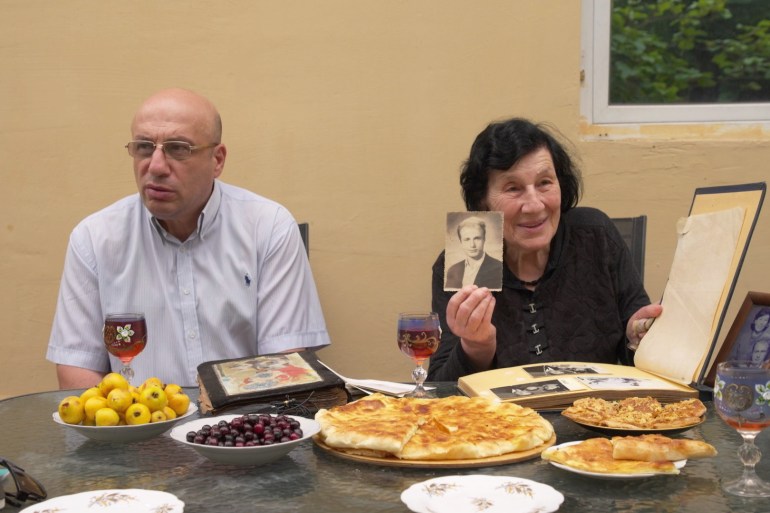
Analysing the remains
Slowly, the skeletons are yielding their dark secrets.
“The NKVD documented their crime,” says Meri. “I have 28 execution documents of individuals who were executed on December 27, 1937.”
Meri’s team suspected that the documents might belong to the victims her team excavated from Grave 5. That hypothesis proved correct.
Collaborating with a genetics laboratory from Poland, three individuals were identified. Their bone samples matched the DNA of some of the surviving family members of the named victims tracked down by a Georgian television producer working on a documentary about the project.
But progress has faltered.
The method they used to cross-reference DNA, though relatively inexpensive, has limitations and was unable to establish a definitive link between the other remains and reference samples from living descendants.
“We need more families to be involved, and it’s difficult to establish a positive match as we are now dealing with second or third generations, grandchildren and great-grandchildren,” Meri explains.
A different DNA sequencing technology that is better at determining more distant relationships could solve that problem. To date, their Polish partners have covered the costs, but the alternative technology is up to five times more expensive to operate.
Meanwhile, an investigation to identify the victims of Grave 6 has stalled. IDFI’s team has not been able to finance DNA analysis of any of the 29 skeletal remains uncovered there.
Anton Vacharadze, head of memory and disinformation studies at IDFI, says it is “particularly regrettable,” given that forensic analysis has revealed a female individual among the skeletal remains.
IDFI has an official list of 29 individuals executed on March 15, 1938 from Georgia’s Ministry of Internal Affairs archive. Among them is a female. Given that just 11 women are believed to have been executed in Adjara during that period, a match between the 29 victims and the document from the archive seems likely.
“DNA analysis for 29 remains will cost more than $20,000 – impossible for a nongovernmental organisation, and the state does not finance this process,” Vacharadze says.
Then there is the issue of outreach. Although IDFI researchers have identified a total of 1,050 executed individuals in Adjara, there is no centralised contact database of living descendants, and no coordinated communication strategy to invite more people to come forward for DNA analysis.

Hasan: the man with the leather boots
A portrait of Natalia’s grandfather Hasan, possibly when he was in his 20s, stands on a side table in the living room of the Kuznetsova family home. He looks boyish and wears a military-style tunic and knee-high riding boots. He strikes a slightly awkward pose, his hands on his hips, and his thumbs inserted behind his waist belt. It is the only picture of him they have.
Natalia and her mother, Eteri Kuznetsova, 69, sit at the dining room table.
“My husband Iakob was just two years old when Hasan was taken away,” Eteri sighs. “This is how he always remembered his father, by the leather boots he was wearing.”
Meri took DNA reference samples from the family in 2022. When the lab results came through, Hasan was among the victims found at Grave 5.
In June 2023, Eteri and Natalia met with the Adjaran special commission.
A court had approved a death certificate for the family, and the commission concluded that there were no further grounds for withholding his body.
The women emerged from the meeting triumphant. Hasan’s remains had been lying for almost three years in a cardboard box under GAFA’s supervision at BAU International University Batumi.
For Eteri, however, there was one lingering regret: That her husband Iakob, who died in 2020, would not be there to see his father return home.
Back at the family home, Natalia finds a copy of Hasan’s execution document taken from the state archive. She runs a finger across the faded Cyrillic print.
“Dishli Oglu, Hasan Yakubovich. Shot. But who were the ones who signed the execution order?” she asks, pointing to the signatures of three Soviet officials, known as a troika, who together could decide whether a person lived, or died.
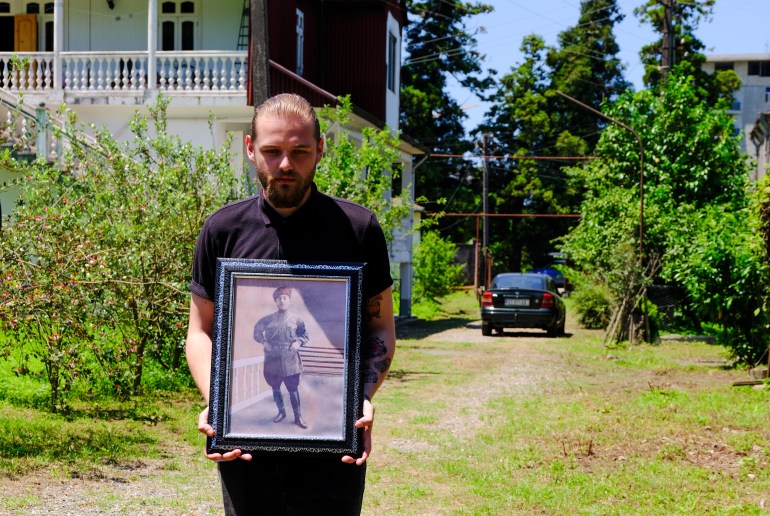
Stalin’s ghost
Under Soviet leader Nikita Khrushchev’s policy of de-Stalinisation, families of many of the victims were issued letters during the 1950s and 1960s, posthumously overturning their relatives’ convictions.
And that, for many, is where the story officially ended.
When the Soviet Union dissolved in 1991, an independent Georgia re-emerged. But there was to be no truth and reconciliation programme unlike in other post-Soviet bloc countries such as Poland, the former East Germany, Romania and the Baltic states.
Vacharadze of IDFI says civil society organisations are determined to shine a light onto this dark chapter in Georgian history where families lost loved ones through executions and forced exile. But, he says, there is little appetite for a public inquiry into Soviet-era repression. “A significant portion of society views our earnest efforts and advocacy as a waste of time,” he explains.
Poverty and unemployment remain serious challenges in Georgia. And, mindful of the country’s troubled history under Russian and later Soviet imperialism, Georgian society remains fearful about a return to conflict, especially given Russia’s invasion of Ukraine.
“They argue that society faces much larger problems than events from 85 years ago,” Vacharadze says.
Successive Georgian governments have also shown a reluctance to back research.
“The state says, ‘It happened, we know, so let’s move forward and focus on our victories and something glorious, not traumatic,’” he explains. “And there are still people influencing our everyday life from that period, politicians who are descended from Communist Party members. … They simply don’t want to reveal past crimes committed by their [ancestors].”
He adds: “It’s an endless cycle of power exercised by families who were active both then and now.”
Today a battleground over Stalin and the wider Soviet legacy persists. There are limits on what is taught in the education system, and a leading institute on Georgia’s Soviet legacy, SovLab, has accused the government of increasingly restricting access to the state archives.
SovLab and others emphasise that the weaponisation of history in Russia under current President Vladimir Putin has sought to rehabilitate Stalin, and the Kremlin’s disinformation campaigns have had a significant influence on the public discourse in Georgia, amplified by Georgia’s own political elite. Given the absence of informed, public debate, Soviet-era state crimes are poorly understood, even denied, says Tinatin Japaridze, author of the 2022 book Stalin’s Millennials.
Polls continue to show that many Georgians still hold Stalin in high regard, especially for having been the most powerful leader to have emerged from the country.
In her book, Japaridze argues that Stalin remains at the core of a post-Soviet identity crisis in Georgia where his “omnipresent ghost” haunts a divided society. She also draws from her own family’s experience of repression. Japaridze’s great-aunt Nina Chichua-Bedia and her husband Erik Bedia were both executed. But Bedia was editor in chief of the Komunisti newspaper and as a propagandist complicit in supporting the regime.
“We, as a family, were not just victims. We were participating somewhat in these processes,” she explains. “We as a country need to accept responsibility, to a degree, for everything that transpired.
“The victims that died as a result of these purges and repressions were not just the victims of Joseph Stalin. There were those who stood on the sidelines and stayed quiet.”
And when it comes to investigating the mass graves, authorities seem more focused on reburial rather than identifying and excavating more gravesites.
“We won’t wait long,” says Nino Nizharadze, Adjara’s health minister, who heads the special commission. “The first 150 remains are still in the examination phase.
“Once the DNA samples have been processed and stored for further research – the topic of their burial will be discussed.”
![Georgia's ghosts [Robin Forestier-Walker/Al Jazeera]](https://www.aljazeera.com/wp-content/uploads/2024/01/DSF2652-1704888729.jpg?w=770&resize=770%2C578)
Dacha of death
Meri stands before a line of barbed wire at the Khelvachauri military base. Just beyond lies a decaying Soviet housing block for the garrison once stationed there.
In front, an observation tower leans sideways, the twisted frame suggesting imminent collapse. This was a site of mass murder.
“It’s not only this area where we have the gravesites,” Meri says. “There are much more, many more in Georgia. Fifteen thousand people are missing and they need to be found.”
Gravesites are known to exist elsewhere in the country including the capital Tbilisi, but only their approximate locations are known.
One mass grave is rumoured to lie on the grounds of a luxurious country home built to house the main regional office of the Soviet leadership.
The building, with its colonnade, terraces and balconies, is a palatial mix of European, Soviet neoclassical and Georgian architecture.
It is perched on a steep hill in the thickly forested Adjaran countryside.
Akhmed Mekeidze, 67, peers through the iron entrance gate leading to what is locally known as Beria’s dacha, after Lavrentiy Beria, a senior Communist Party leader who became head of the NKVD in 1938. Beria oversaw the political purges in Georgia during the Terror.

Today, the dacha is privately owned, and closed to the public.
Akhmed’s cropped hair has turned silver, but his moustache is still tinted with the auburn colour of his youth.
“There is talk that this was a slaughterhouse. All the prisoners used to be brought here and distributed from here or killed here,” Akhmed explains. “I remember my grandfather’s brothers saying for a long time there was a terrible smell coming from this area, probably people were not buried properly.”
Though he was not born until 20 years after his grandfather’s disappearance in 1936, Akhmed says he remembers as a child how his grandmother used to cry all the time.
“I made a childhood promise to her that I would bring my grandfather back,” he says.
Akhmed worked as a farm labourer and used to make a little money on the side reselling goods, a practice that was illegal at the time. As soon as he earned enough money, he would spend it on travel to penal colonies in far-flung corners of the Soviet empire in search of his grandfather Akhmed, hoping that his namesake had been deported and not executed.
But in 2019, he discovered his grandfather’s name was the 51st entry on the IDFI’s list of Adjaran victims. In 2023, he provided a DNA test. He is still waiting for an answer.
Akhmed studiously ignores the fierce-looking mountain dog barking ferociously from behind the gate. Though he hopes the dacha might hold the secret to his grandfather’s disappearance, he acknowledges the remains could be anywhere.
“I have sent letters to the president, the prime minister, the Ministry of Internal Affairs, demanding research and opening of graves. Everyone is writing to me sincerely, they tell me to wait – and I am waiting,” he says.
Had his grandmother, who died in the 1980s, lived to see her husband’s remains returned, she would have found peace, he believes.
Perhaps someday the owners will allow experts to investigate the dacha. Until then, Akhmed has a space reserved for his grandfather beside his grandmother in the family plot at the local cemetery.
“As long as I live,” Akhmed says, “I will try to fulfil that request and bury him along with his wife, his mother and his two children.”
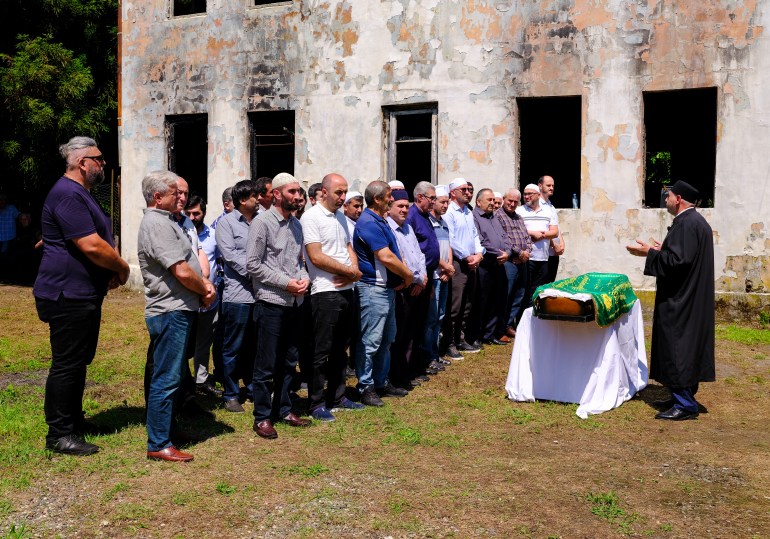
A funeral
Given the present lack of funding and a prevailing political indifference, the rest of Stalin’s victims in Georgia may never be found, let alone identified.
For this reason, Zura hopes that a large tomb will be funded by the local government and erected on the military base and that it can serve as a “holy place”.
“We still do not know where our ancestors lie, but we want that place to be where we can honour their memory,” he explains.
The families Meri is in regular contact with have one wish. “They want their loved ones home,” she says.
On a hot, humid weekend last June, Meri travelled to Batumi to help Natalia and Eteri prepare Hasan’s remains for burial.
Family, friends and members of the local Muslim community gathered in the backyard of their home.
Since Georgia’s independence, many Adjarans have converted to Orthodox Christianity, including Natalia and her brother Valery. But in accordance with Hasan’s faith, the family gave him a Muslim funeral.
Meri and Natalia unpack Hasan’s bones from the box, and place them onto a white funeral shroud. Meri carefully reassembles his skeleton in the sunshine.
The ruin of Hasan’s house offers shade to Eteri, dressed in a black dress and headscarf, who sits quietly while the imam intones a Quranic prayer.
Akhmed and Zura come to pay their respects. The discovery of Adjara’s mass graves has moulded the families of Stalin’s victims into something of a community.
Alongside the roaring traffic, the pallbearers walk the casket solemnly along the main road to a nearby cemetery.
Hasan’s portrait leans against his son Iakob’s tombstone as the coffin is lowered into an adjacent grave.
Eteri strokes her husband’s image, etched into the black granite. “What precious children Hasan left us,” Eteri sobs, “and what a precious family you left me.”
“I have bittersweet feelings, as if I was burying the missing relatives of my own family,” says Zura. “But we have begun to hope.”
